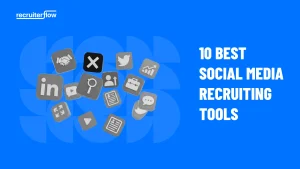
Creating Strategic Recruitment Plan [+ Free Templates]

According to the U.S. Department of Labor, a bad hire can cost up to 30% of the employee’s first-year earnings. However, in the recruitment business, this cost can be even more significant. A poor hire can strain client relationships and jeopardize future business opportunities. This underscores the need for a solid recruitment plan for your agency.
In this blog, we’ll explore how to create a strategic recruitment plan that doesn’t crack under tight deadlines or high-volume hiring.
What is a recruitment plan?
A recruitment plan is a strategic framework to optimize and streamline every stage in hiring– from sourcing to onboarding. It sets clear timelines and expectations for recruiters and hiring managers. It also serves as a guiding star in filling client vacancies.
Components of a recruitment plan
While every opening can be unique, a solid recruitment plan comprises 4 things that are needed for any kind of hiring.
- Defining the recruitment goals
- Understanding the job requirements
- Budget allocation
- Developing a recruiting strategy
A good recruitment plan anticipates the needs and challenges that may arise at each stage. And lays out a step-by-step strategy to enhance hiring efficiency.
How to create a strategic recruitment plan?
Step 1:Define the recruitment goals
Figure out what roles need to be filled. Each department pitches in with its requirements at this stage. This lets you create a bird’s eye view of the planned hiring for the year.
Next, identify the KPIs you’re targeting over the next quarters such as– improving your time-to-fill, increasing diversity, reducing turnover, and so on. Once the recruitment goals are set, you can shift your focus to each open position.
Step 2: Skill gap analysis
Research thoroughly about the open roles. The skills the job demands today might have changed since your last hiring. Do a skill gap analysis to spot the skill gap and bring in candidates who can fill the same.
Remember, not every new opening has to be an outside hire. This can be a great opportunity to upskill talent within the organization and promote them.
Step 3: Budget allocation
Calculate the initial cost of hire for each role using the industry benchmarks as a reference. You can then draw up a hiring budget adding the initial cost with other recruitment expenses like using an ATS, job portals, marketing expenses, etc. We have added a template for this at the end of the blog.
To manage these costs more efficiently, consider using a business credit card with no annual fees to track and categorize your recruitment-related expenses without added overhead. This can help streamline your budgeting while earning rewards or cashback.
Also, read our blog on recruitment marketing to discover strategies that help you attract and engage top talent effectively.
Step 4: Develop a hiring strategy
A recruiting plan without a recruiting strategy is like a car without fuel; it can’t go anywhere. Let’s have a look at how to build a solid recruiting strategy.
- Establish timeline
Before you begin hiring, every role needs to have a realistic timeline. Set milestones for each stage of the interview. This helps you track the time to fill.
- Sourcing strategy
You can’t post willy-nilly on any job posting site. A great opening with poor visibility won’t yield any results for you. So, you must know which job board works best for each vacancy.
[Want a little help in identifying them? Read our blog on the best job posting sites.]
Finally don’t forget to have an easy-to-use referral system, as in-house resources are your most trusted source.
Once your position is live, the next challenge is sourcing skilled candidates. Use candidate sourcing tools to leverage untapped talent pools for you (as well as your clients.) We’ve compiled a list of the best candidate sourcing tools for you.
- Screening & Interviewing
Recruiterflow ATS helps recruiters to automate various parts of the screening and interviewing process. Features like AI candidate matching, automatic interview scheduling, and a calendar widget help recruiters focus on the complex part of the interview and screening i.e. gauging the candidate fit for the role.
However, with little time to gauge how well a candidate fits into your system, it’s crucial to ask your candidates the right interview questions. [Read our list of strategic interview questions to ask candidates.]
- Onboarding
The candidate signs the offer letter, but does that mean the job’s done? Hardly.
The final step in your hiring strategy is having a good onboarding process. It allows the new hires to familiarize themselves with your culture, philosophies, goals, and processes. It lets them integrate into the system and become effective contributors quickly.
Without a good onboarding, you leave the new hires deep in the trenches to figure things out themselves. This can lower their morale and make them wonder if they are the right fit for the role. Retaining employees can become harder this way. Studies suggest a strong onboarding process improves new hire retention by 82%
- Monitoring and revising
“A plan that’s not monitored is half-baked at best”.
Monitor key metrics like time-to-fill, cost-per-hire, time-to-hire, etc are good to know but they can’t give you the whole picture. To get that you need to ask questions like-
- Which sourcing platform worked best?
- What was the quality of leads generated?
- Was the candidate’s experience good during the recruitment process?
- Are you meeting your goals? (eg: diversity needs)
- Are the hiring managers interviewing enough candidates?
You can also check out our guide on the best recruitment marketing tools.
Step 5: Leverage technology
Leveraging AI and automation doesn’t just help you fast-track your hiring process, but also helps you fill your client’s vacancies faster and more efficiently. Studies suggest recruiters can significantly reduce the time spent on sourcing by around 30% with recruiting AI.
Using modern applicant tracking systems like Recruiterflow, you can automate various parts of your recruitment workflows.
- Using integrations with job boards and social media you can post your openings to multiple places in one click.
- Customize your recruitment pipelines to enhance your efficiency.
- Email and calendar sync allows you to keep track of all important meetings in one place
- Automated email templates to reduce repetitive tasks and time-to-hire
- Advanced filters to pull all candidate information directly into your dashboard, parse resumes, and schedule interviews
- Helps in passive candidate management
- Advanced recipes in boolean search to filter candidates from a talent pool
- Quick overview of which candidates are progressing through the interview stages
- Automatic candidate disqualification when you close a job helps you maintain the data sanity.
A good strategic hiring plan doesn’t offer a one size fits all kind of solution, but can easily be fit into any situation with a little customization. If your recruitment plan is moving in this direction, that’s a sign you’re on the right track.
Free Recruitment Plan Templates
To help you create your recruitment plan, here are some customizable recruitment plan templates. You can download our free recruiting email templates by clicking on the banner below!

Ready to enhance your recruitment planning process?
Book a free demo.



Abhishek Sharma